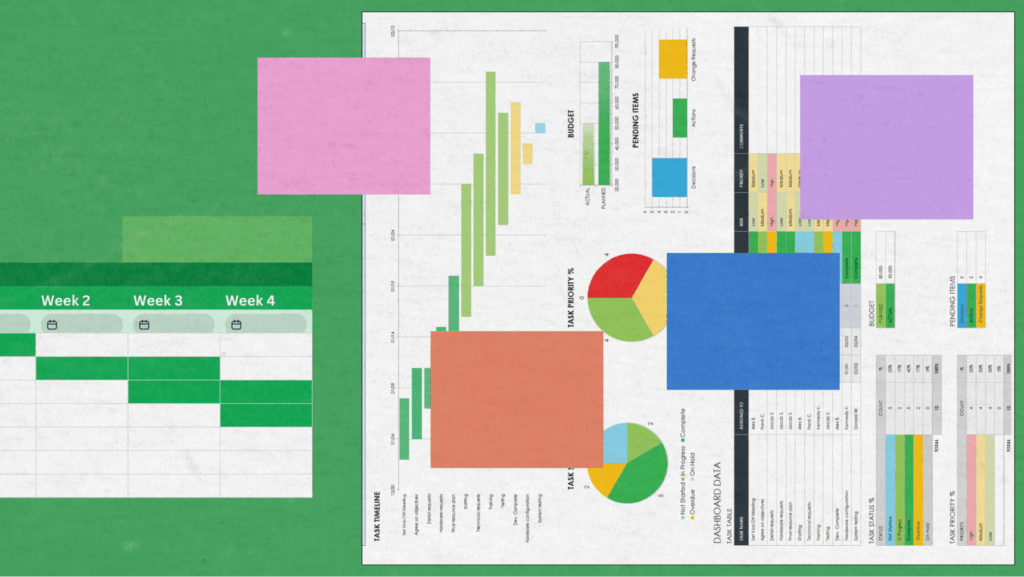Websites have moved far beyond static pages. Today, they’re true business engines constantly active, always evolving, and continuously selling. Here’s the catch: if your website doesn’t deliver, visitors won’t give you another shot. HubSpot reports that 88% of consumers don’t return after a poor experience. That’s why effective website management is essential.
It’s not just about fixing bugs or running updates. Strong management is about continuous improvement, refining your design, boosting speed, and ensuring every step matches your brand’s broader objectives. It means keeping your site sharp, secure, and genuinely engaging for your target audience.
In this guide, I’ll explain what makes a website truly succeed in 2025. We’ll cover smart systems, content that attracts search engines, and the right people and website management tools to bring it all together. If you want your website to be a real asset to your business instead of just existing, this is where to begin.
TL;DR
It is not enough to simply establish your website and then go off on your own way if you want to keep your site running fast, safe, and prepared for any eventuality. Site management in 2025 is akin to handling a business tool that is alive and kicking. You are continuously redesigning, checking the site’s performance, uploading fresh content, and tweaking your strategy — all these activities being powered by genuine data, efficient search engine optimization (SEO), and, last but not least of all, a focus on what your visitors really want.
The right instruments will make you see how everything, from the everyday management to the lengthy planning, gets eased up. The goal? To produce a platform that users are willing to visit and keep coming back to.
Key Takeaways
- Good website management is ongoing. You don’t just launch it and leave it alone.
- Keep everything updated and working well, and people will trust your brand more.
- A reliable content management system makes adding new content much simpler, especially as you expand.
- Modern website management tools and analytics aren’t just nice to look at; they offer real insight into what’s effective (and what isn’t).
- When your website supports your marketing goals, you get more visitors, higher engagement, and real business results.
What Is Website Management?
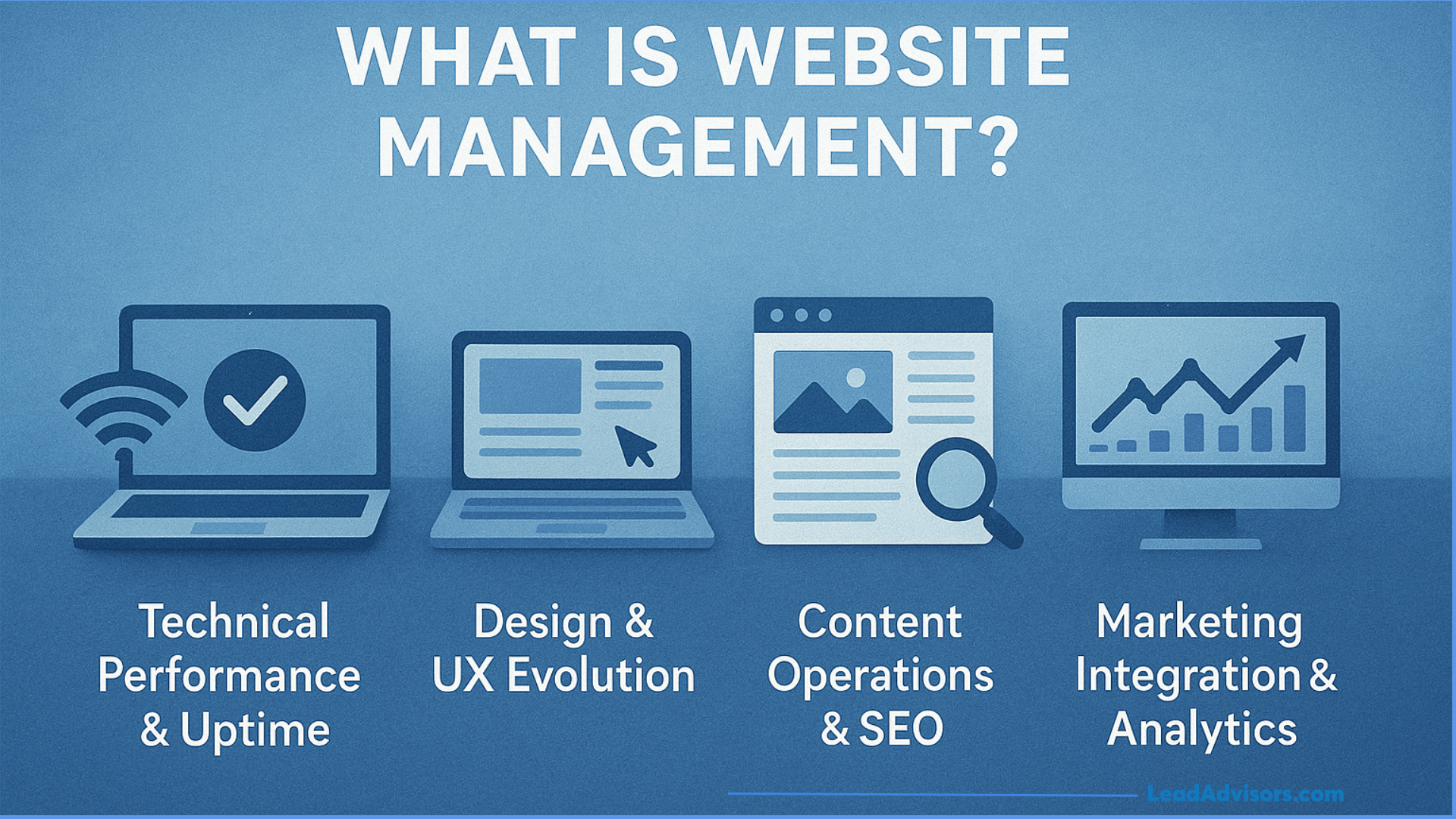
Whenever I mention website management, I’m not only referring to the act of fixing minor bugs or upgrading plugins. It’s a continuous website management process, always striving to make your site better. It covers every aspect, from the implementation of the fresh design ideas and the acceleration of the loading times to the new content, security, and even your marketing campaigns. Basically, it’s a non-stop work to make your website faster, more intelligent, and more useful to every visitor.
Real website management is a combination of your brand’s personality, your search engine optimization (SEO) strategies, and the routine of website management tasks. It’s far beyond simply having a site that looks nice. You want it to have a high position in search engines and be a perfect match with your broader digital marketing objectives.
Good website management is primarily based on four main pillars:
- Technical Performance & Uptime – Ensuring that everything is operating smoothly, securely, and quickly is up to you.
- Design & UX Evolution – Your website needs to be easy to use for the visitors and able to follow the new trends.
- Content Operations & SEO – Keep your CMS up-to-date, polish your content, and let the people find you.
- Marketing Integration & Analytics – Use your data to track progress and know what works.
These four pillars are the cornerstone of a solid and expanding online presence. If you are serious about the success of your website, this is where you should start.
Why Website Management Matters for Businesses
In fact, your site is the brand you are existing on the internet and not just a conventional printed brochure transferred to the web. It is the manner in which you handle your site that has an effect on people’s image of you, whether you are operating a small business or a big company.
Proper administration is like an efficient engine; it is the main factor that keeps the whole system functioning correctly, it is what makes people believe in you, and it is what attracts new clients to make purchases or to stay longer on your website.
Enhances User Experience and Engagement
We can’t deny the fact that your site is usually the very first thing that people see about your brand. So if your site is fast, responsive, and has a user-friendly interface, visitors will definitely stay longer and do what you want them to do.
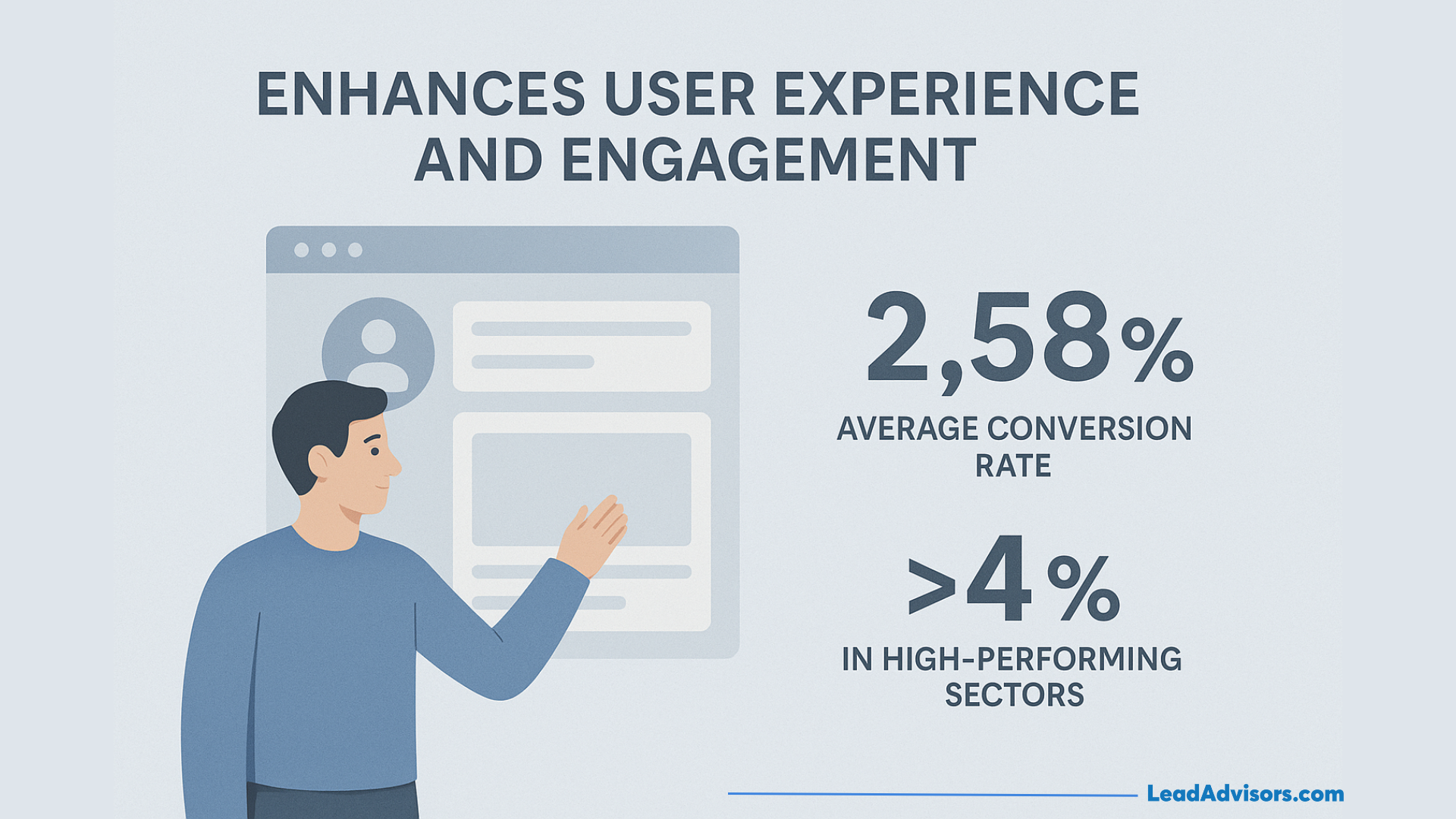
The truth is that typical online store website conversion rates are approximately 2.58% worldwide, where a few niche market sectors can even achieve a conversion rate of more than 4%. Thus, refreshing, fine-tuning, and tidying up your website is not merely a nice gesture, but rather the very thing that makes the visitors return and thus converts them from casual visitors into loyal customers.
Builds Trust and Credibility
People do realize when you put your attention there. A website that is kept up-to-date regularly, has new content, and good security gives the impression of being a safe and reliable place, thus trust is built in a natural way. When users come across a website that is current and well-maintained, they are much more likely to stay.
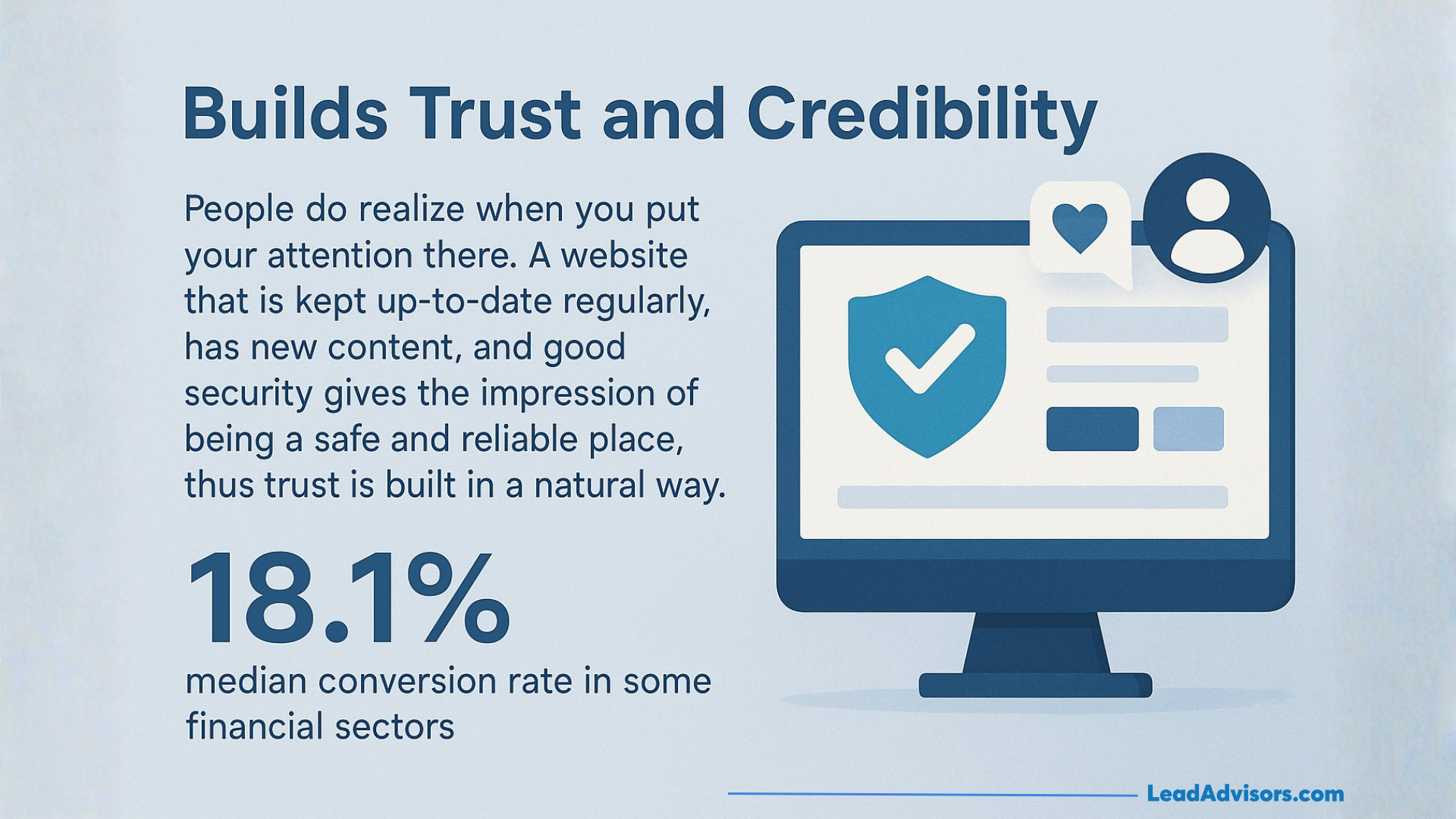
Conversion rates, therefore, can be your calling by which they increase very rapidly when you combine that with clear calls-to-action, easy-to-understand copy, and trust enhancers like customer testimonials. To be more precise, content that was written at a level understandable by a 5th–7th grader was the reason for an 18.1% median conversion rate in some financial sectors — a fact that serves as an indication that trust and clarity are closely related.
Improves Search Visibility
Would you like your website to be on the first page of Google search results? The truth is, you need to work on your site continuously. New content, quick loading times, and a well-organized website are what search engines look for. By keeping all your updates and upgrades running, you give a sign to Google that your site is still alive and it can be trusted – the result is more visibility and more traffic.
Additionally, it is very effective: conversion rates driven by SEO typically vary from 2.1% B2C to 2.6% B2B, which is an indication of how powerful SEO and regular content updates are in directly leading to better rankings and stronger results.
Read our blog How To Get Your Name or Brand On Top Of Google Search to know more about search visibility.
Prevents Technical Debt and Costly Fixes
Not taking care of your website’s updates or small issues might scare you in the future with broken links, slow pages, or even security threats. Such errors not only irritate the users but also damage your conversions.
A website with slow loading and technical issues is the one that usually witnesses a decline in its conversion rates; thus, maintenance is a must. Being on the ball retains your site in a proper state, ensures your results, and it is like insurance against expensive repairs later on. Above all, it saves you from missing out on potential customers because of issues that could have been easily averted.
Protects Brand Performance
People may not always say it, but they clearly see it — and it’s a fact that your brand can be damaged more than you realize if your website is still stuck in the past or is slow to load. However, you give a very professional and trustworthy signal when your website is always in good shape and works without problems.
Such attention increases your brand’s power online and is the real basis for business growth. To put it simply, upholding the appeal and the smooth running of a website is a great conversion rate enhancer, which is a direct lead to more income and bigger brand authority in the long run.
The Core Components of a Website Management System
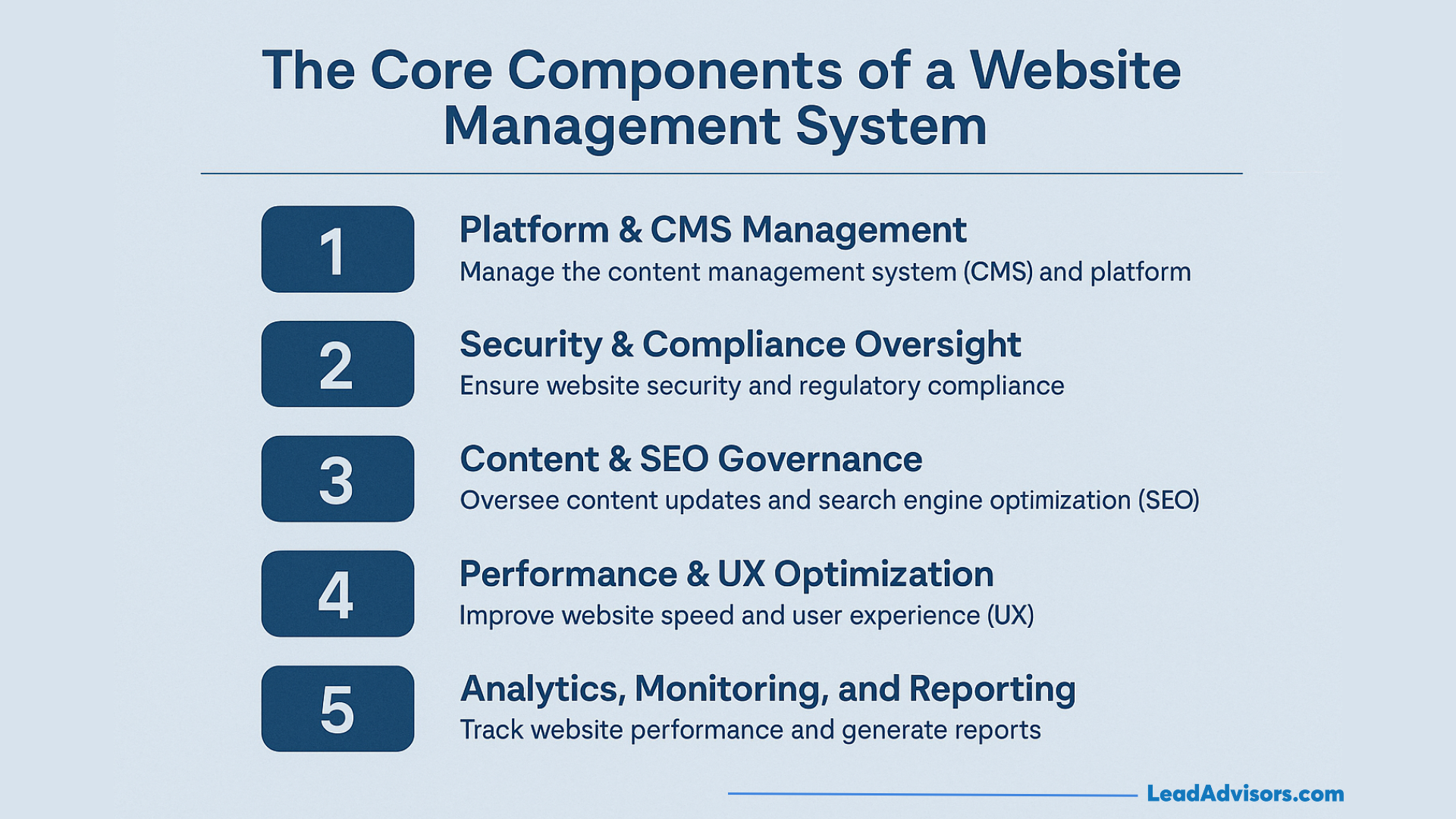
It is not only about putting out a couple of web pages and considering the work done when managing a website. At the same time, you are dealing with technology, content, and users’ experience. In case everything is functioning properly, your website will remain stable, safe, and scalable. This is the operation of a well-functioning website management system.
1. Platform & Content Management System (CMS)
If you consider your CMS as the core that provides the power to your website. With the correct one, posting is simple, the work between the team is effective, and the growth of your site does not bring you any trouble. No matter if it’s Webflow or WordPress, HubSpot or Salesforce, or some other alternative, what matters is that the system should be flexible and support SEO.
There are times when your CMS is not able to meet your expectations; it might be slow, a bit complicated, or difficult to customize. Making an upgrade to a more powerful platform not only makes your brand look more cohesive but also can increase your search rankings. Your CMS is the one that defines the rules for content editing, tool integration, and site structure maintenance.
2. Security & Compliance Oversight
Security is not an option that you can simply take for granted. Regular inspections are the shields that keep your site away from hacking, malware, and unauthorized access to your data. Encrypt your data, plan your backups in an automated way, and update your firewalls regularly—this is how you make both your users and the regulators feel secure.
Having security measures in place is not only about preventing attacks. There are certain requirements that need to be met: ADA, GDPR, and CCPA, to name a few. Being compliant is not just about saving from monetary fines—it reflects that your site is accessible, transparent, and reliable. Keep an eye on these security and compliance measures and have them always available on your dashboard so that you are always up to date.
3. Content & SEO Governance
The content is basically the reason people visit your website. Making sure it is always updated and correct is a perpetual work. Create a content calendar, plan your keywords, and be sure that your internal links are effectively connecting everything. This is the way you get higher positions in search results.
They are really important here. You have to record everything the users do. They read, click, or skip? Adjust your content and social media marketing strategy using this data. Efficient SEO is not only a list of tasks; it is what allows your site to be seen and to stay competitive.
4. Performance & UX Optimization
A slow and clumsy website is something that no one would want to stay on. Such tests should be carried out on your site regularly to check its speed, responsiveness, and layout stability. A fast and user-friendly interface is a great way to keep your visitors engaged and willing to convert.
It’s a good idea to renew your look every couple of years so that it is in line with the latest requirements and technological advances. Analyze and get the feedback from users—these instruments are helping you to locate the strong and weak points so that you can constantly enhance the experience.
5. Analytics, Monitoring, and Reporting
Operating without accurate data means that you are roaming in the dark. Keep a record of metrics such as uptime, loading speed, conversions, and users’ interactions with your content. Compile monthly or quarterly reports to keep track of your advancement.
Google Analytics and Google Search Console, among other website management tools, provide great assistance to a company—they open the door for new trends, alert the company in advance about potential issues, and indicate what is having an impact. The main point of the whole thing is not to have a lot of data but to use it for the purpose of bringing significant changes. This, basically, is the essence of successful website management.
Explore our blog about the best rank tracker tools in 2025 to get some insights on what you can use in monitoring your website.
People & Processes: Who Manages the Website
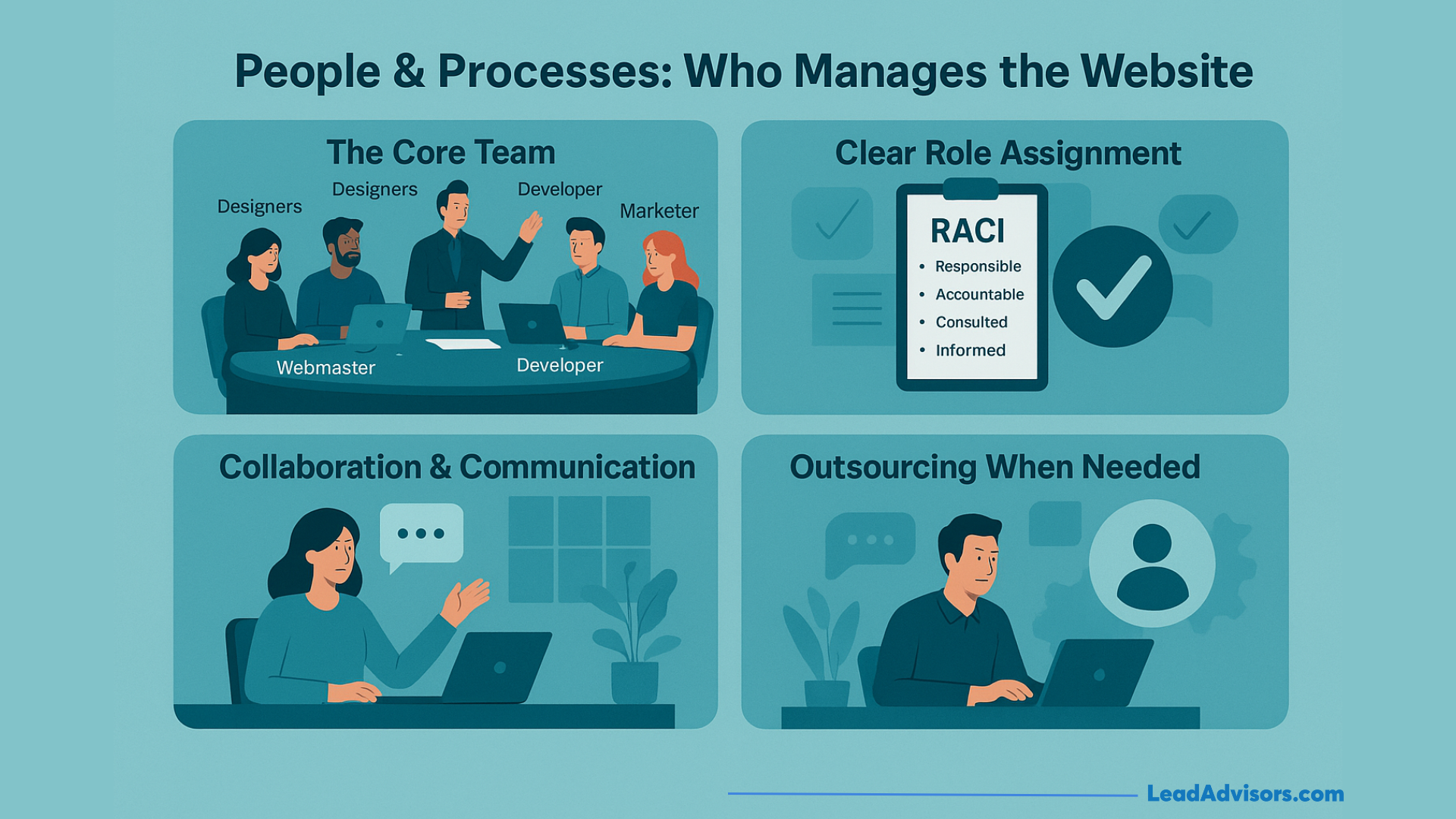
It takes a team to operate a website that truly delivers. No one manages it alone. Every well-run and effective site relies on a group of people and reliable routines to keep things together.
- The Core Team:
It all starts with the team. The person in charge of the website is like the conductor of an orchestra. He or she is the one who sees the big picture and ensures that the whole team is aligned with the strategy. A webmaster is the one who is like the engine of the car, which keeps the site running smoothly every day. Designers are the ones who decide the style and the user experience. Developers are the ones who write the code and handle all the technical integrations that are invisible to the users. Marketers are the ones who ensure that the website is in harmony with the overall digital marketing plan. - Clear Role Assignment:
In order to clarify the roles, many teams use the RACI framework. This defines the four categories of roles: those who are Responsible, those who are Accountable, those who are consulted, and those who are informed for each task. Even though it looks like something very simple, it is very important for the system of accountability. By means of such a system, things such as refreshing the content, repairing bugs, and performing website security checks are actually carried out — and everything gets done. - Collaboration & Communication:
Powerful teamwork is what makes the system work. Team members use such instruments as Trello, Slack, or ClickUp to communicate with each other and to monitor their daily tasks. These website management tools facilitate the work of creative and technical teams in that they stay coordinated, questions are solved quickly, and they get more work done. - Outsourcing When Needed:
Occasionally, a situation arises where a team lacks the required capacity or a certain expertise that is not available internally. Therefore, the act of outsourcing becomes a solution. The involvement of a third party in areas such as optimization, analytics, or monitoring can allow your team to dedicate the rest of the time to other tasks that are of higher priority. In addition to this, the team gets to use the latest technology and to benefit from the skills without the need for the team to develop everything on their own; thus, the majority of the time, it is a money-saving option as compared to hiring extra employees.
If you have the right people, strong systems, and the best tools, your site will be more than simply a digital presence. It changes and grows with your company, thus becoming a real power unit for your goals.
Website Management Strategy Framework
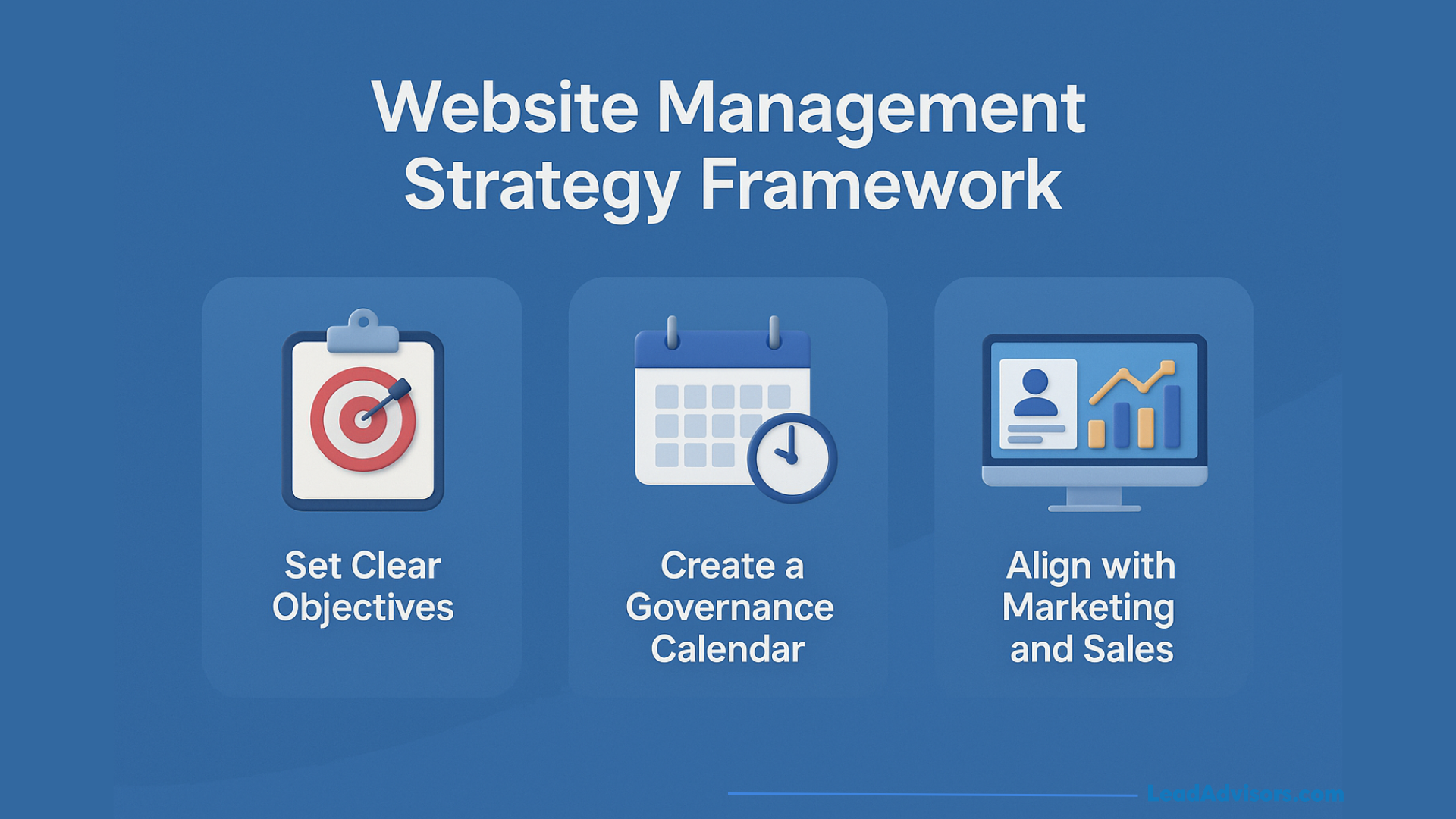
An effective website is not by chance. It needs to have a framework, a goal, and a definite link between what you do daily and your future goals. In case you desire your website to grow along with your brand, you certainly need a management plan that unites all these elements.
Set Clear Objectives
Start by figuring out what your goals are. What would success mean for you? Maybe you want to get more leads, increase sales, or make the customers’ experience easier. No matter what you are aiming at, make sure that the goals for your website are consistent with actual business metrics such as traffic, conversions, or engagement. Knowing your way there, every move makes sense, and you are able to measure what is really working.
Create a Governance Calendar
Consistency keeps your website performing at its best. Establish a simple routine:
- Each week, monitor uptime and review analytics.
- Monthly, refine your content for SEO, update plugins, and check your key pages.
- Quarterly, assess your design and see how you compare to competitors.
- Annually, evaluate scalability, review your site’s architecture, and check your hosting.
With a governance calendar, you transform website maintenance services into a manageable process. Staying organized becomes easier, and you lay the groundwork for lasting stability.
Discover the best digital calendar for 2025 to enhance your productivity and seamlessly manage your personal and work schedules.
Align with Marketing and Sales
Technology is like an ecosystem where a different part of a website is a node. In your case, a website is a node. However, this node does not exist independently but is connected to other nodes, i.e., CRM, analytics, and advertising platforms, through channels that are data marketing and selling. Indulge automation and personalization to attract users and convert them at the best possible rate. With the proper instruments, you are capable of transforming data into valuable insights that can be acted upon.
When these components are harmonized, handling a website is not only about fixing the issues anymore. It is becoming a tool that helps the business website expand by strengthening the online presence and making it viable for any situation that may arise.
Website Management Services Tools for 2025
Keeping a website alive in 2025 is not just about mere existence; but it is the art of mixing creativity with state-of-the-art technology. There is a lot of work involved: rankings on the web, site speeds, teamwork, and protection.
The positive side of the story is that contemporary web management tools take care of all these issues and even beyond. They employ automation, AI, and smart data to make sure that your site stays speedy, safe, and is always up to date with the latest trends.
| Function | Example Capabilities | Key Outcomes |
| CMS & Website Builders | Content editing, visual design, scalable structure | Efficient publishing and collaboration |
| Security & Backups | Automated backups, malware scanning, and firewall protection | Minimized risk and downtime |
| Performance Monitoring | Speed testing, optimization tracking | Faster loading and better UX |
| SEO & Marketing | Keyword tracking, audit reports, and on-page optimization | Increased organic visibility |
| Analytics & Reporting | Traffic analysis, conversion tracking, dashboards | Data-driven decision-making |
| Collaboration & Project Management | Task assignments, progress tracking, and documentation | Transparent workflows and accountability |
Every web management instrument is different from the other. Content management systems are in charge of publishing, whereas the rest of the instruments are taking care of site health and performance. Analytics and project management platforms are the means of communication between everything, so your team understands what is effective and what requires their attention.
The main goal for 2025 is to integrate all these tools into one seamless system. When the flow of insights, updates, and improvements is uninterrupted, your website is not merely functioning – it is getting more powerful and staying a step ahead for the future.
Outsourcing vs In-House: Which Model Is Right for You?
It is a question that every business will have to answer at some point: is it better to handle the website management in-house or engage the services of a professional team? The most suitable option for you will be determined by your requirements, the amount of money you have to spend, and the degree of control that you want to exercise over your website maintenance services.
In-House Website Management
By forming an internal team, you have total control over the situation. You are very much a part of the process, able to decide quickly, change your site, keep track of the stats, and customize the workflows the way you want.
But, on the other hand, this method is associated with increased costs. You have to recruit qualified staff, give them training, and pay for the gadgets and software.
Pros:
- Full creative and operational control
- Immediate communication and decision-making
- Deeper brand understanding
Cons:
- Requires more staff and technical expertise
- Higher overhead for salaries and website management tools
- Slower scaling for complex tasks
Outsourced Website Management
When you outsource, you can hire skilled people such as designers, SEO specialists, and security experts who are professionals in their field at a cost that is usually less than that of a full in-house team. This is the perfect situation for companies that require constant updates but do not have the time or resources to hire developers.
Pros:
- Professional expertise and specialized website management services
- Scalable support without long-term commitments
- Lower operational costs
Cons:
- Less direct control over timing and changes
- Communication delays depending on time zones
- Quality depends on the provider’s standards.
In case you want to outsource, it is better that you pay attention to being transparent, having clear service agreements, reporting, and response times. A lot of companies decide to maintain their strategy as a secret internally and outsource their technical or simple repetitive maintenance tasks.
The main thing is to be consistent, whatever method you take. It doesn’t matter if it is under your own people or specialists whom you can rely on; the main thing is to be sure that your website is kept secure, stable, and prepared for further development.
Building a Scalable Website Management Plan
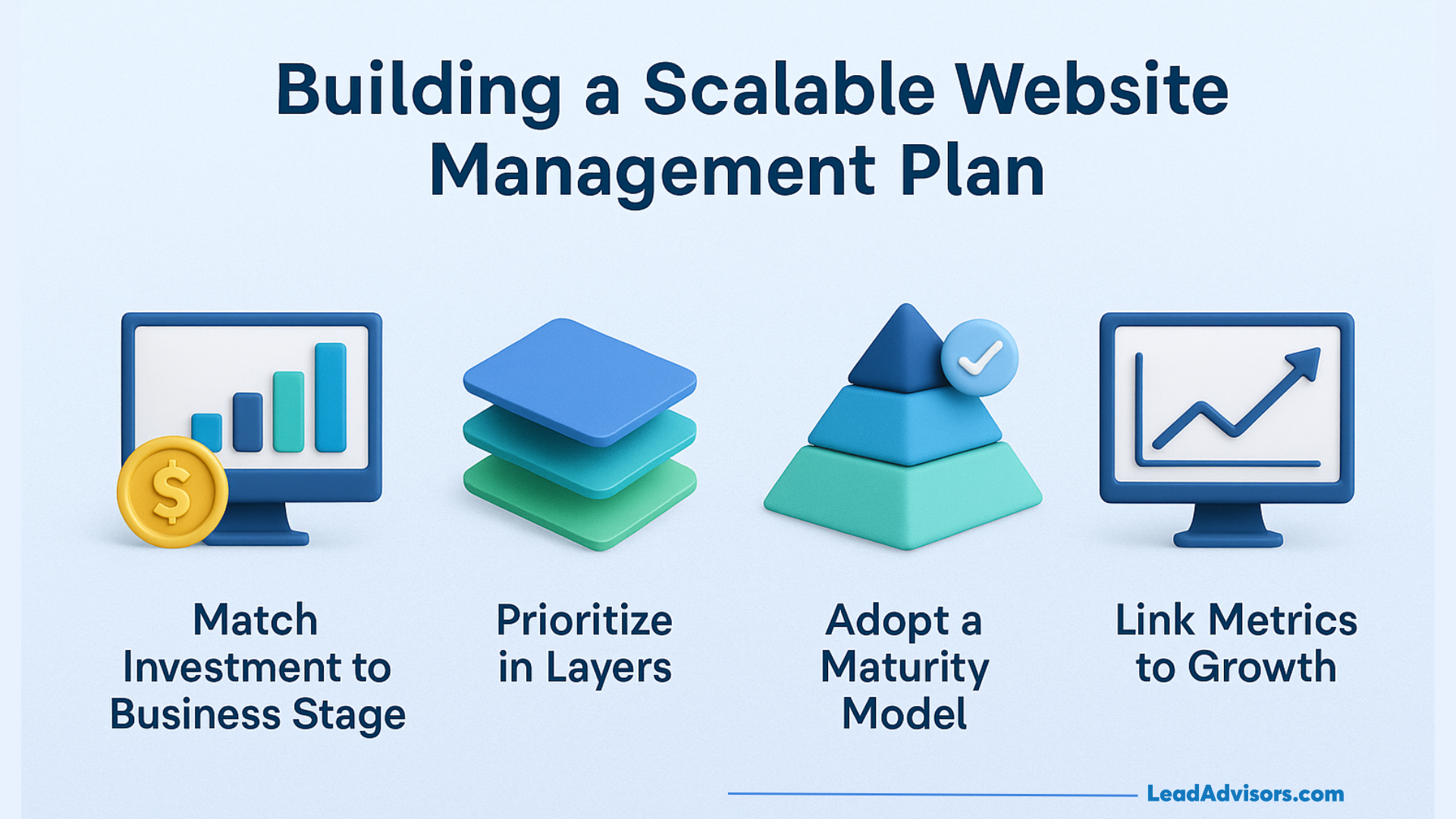
Different websites have different modes of development. In case you are operating a startup with just one main page, a business that is growing and thus a site that is getting busier and busier, or a digital platform of a large enterprise, each of these stages has its own requirements.
The management of your website must also change accordingly. By having a plan that is scalable, you will be able to concentrate on the work that is most important to you, make your working hours more efficient, and keep your site in good working condition while your audience is growing.
Match Investment to Business Stage
Each phase of your business brings unique challenges.
- If you’re at the beginning, focus on essentials: reliable hosting, strong security, and a clean, trustworthy design.
- As your site gains traction, add automation, improved analytics, and perform regular security audits.
- At the enterprise stage, bring in advanced integrations, real-time reporting, and AI-powered optimization.
Aligning your website management with your business’s current needs helps you maximize your investment and avoid wasting time or resources.
Prioritize in Layers
Scaling up means knowing what to handle first and what to save for later. Take it step by step:
- Start with security to protect data and minimize downtime.
- Then, boost your site’s speed and responsiveness—people notice the difference.
- Keep your content updated, valuable, and relevant to your audience.
- Finally, automate routine tasks with smart website management tools so your team can focus on higher-level work.
Each layer strengthens your site. Once you have a solid foundation, you can grow confidently without worrying about instability.
Adopt a Maturity Model
How can you tell if you’re making progress? Think in three stages:
- Level 1 – You’re reacting—solving problems as they arise.
- Level 2 – You’re proactive—anticipating issues by planning ahead and regularly reviewing your site.
- Level 3 – Everything—performance, content, automation—works together as a smart, adaptive system.
Link Metrics to Growth
Ultimately, the strongest management plans connect website data to real business outcomes. Monitor what matters—uptime, conversions, engagement—and tie those numbers to your growth objectives. When every improvement drives results, your website becomes a true growth engine instead of just another cost.
Future Trends in Website Management (2025–2026)
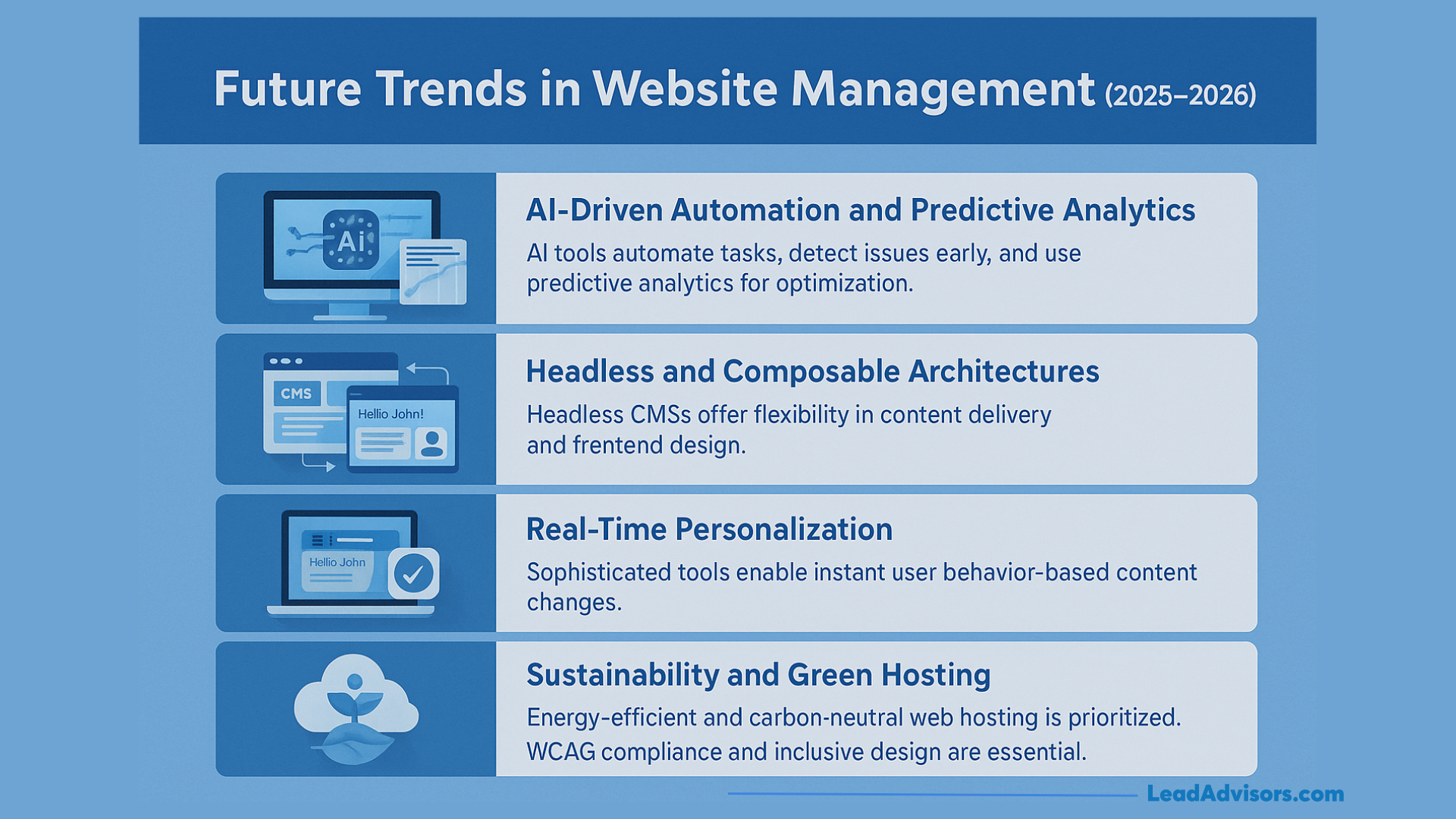
The way we manage websites is changing rapidly, with an increasing emphasis on data and, quite surprisingly, on the human aspect. With tech getting better and better, the firms that are on board with the changes don’t simply maintain their status. They are able to operate at a higher speed, make more profits, and provide more seamless experiences to all their website visitors. These are the factors that are revolutionizing the online world at present.
AI-Driven Automation and Predictive Analytics
Artificial intelligence is not merely a buzzword anymore; it is changing the very way websites are handled. Present-day AI-enabled instruments are capable of figuring out problems locally prior to the escalation of these issues, performing updates, identifying errors, and providing insights that power the smooth operation of a site. In fact, predictive analytics allow you to detect the slowdowns in performance at the earliest stages, thus saving you from the need for constant manual security monitoring and, at the same time, ensuring that the uptime and user experience are enhanced.
According to industry reports, the use of AI-powered automation and predictive analytics will be the main factors behind the huge efficiency gains in digital marketing and website management, which will, in turn, result in the setting of proactive optimization as a new standard by the year 2025.
Headless and Composable Architectures
More and more website management companies are turning to headless CMS, and rightly so. Such systems decouple the front end from the backend, thus providing companies with a lot more freedom in the way they create and distribute content. By using a headless or composable architecture, departments can change layouts, start features that didn’t exist before, or connect up-to-date front-end frameworks without a major system overhaul.
So what is the effect? Websites that load faster, change their design more easily, and marketing campaigns that can be launched quickly. The change is giving brands the opportunity to introduce new features at the speed of a traditional CMS that they cannot simply follow.
Real-Time Personalization
Personalization is going to be a different thing altogether. Next year, it won’t be just a simple thing of calling someone by their name, but it will be reacting to user behavior instantly. Sophisticated personalization tools will be able to look at the actions that are happening even by the second and will preset the content accordingly, thus resulting in a seamless and highly relevant user experience for each and every visitor.
The predictions in digital marketing are that such a real-time interaction will lead to a very high engagement level and conversion rates, and thus to the utmost power of dynamic personalization as a major trend, which is the future of website experiences.
Sustainability and Green Hosting
It looks like sustainability is getting the spotlight it deserves. A good number of brands are opting for energy-efficient servers and carbon-neutral hosting as a way to lessen their digital footprint, and this move is rapidly becoming the very essence of responsible internet usage.
Studies indicate that eco-friendly web design and the use of green hosting providers are not only moral decisions, but they are also turning into substantial competitive advantages as customers decide more and more to patronize those website management companies that take care of the environment in the digital world. Consequently, the use of environmentally friendly hosting and development has become an indispensable part of the strategy of a website.
Accessibility and Inclusive UX
Websites have to be made in such a way that anyone can use them — no ifs, ands, or buts. Complying with standards such as WCAG 2.2 is not merely a matter of checking off a box of conformity; rather, it is about making sure that every visitor is able to use your site without any kind of trouble or irritation. Inclusive design has become an indispensable element of the user experience, rather than just being put in as a last resort.
With accessibility becoming a legal requirement as well as a competitive advantage because of stricter regulations and increased user expectations, it is worthwhile to be on the right side of the law. Compliance with WCAG 2.2 and following the principles of inclusive design not only makes the site more user-friendly to a larger group of people but also enhances the credibility of the business and lessens the chances of it being involved in legal disputes.
To put it simply, the time ahead is for those companies that not only make the right decisions swiftly, but also use data in an intelligent way and create their products with real people in mind. In case you follow these trends, you are doing far more than just having a website. You are operating a vibrant digital environment that is geared towards success in the coming years.
Frequently Asked Questions
What is website management?
What does website management include?
What are website management services?
How much does website management cost?
How does a CMS improve website management?
Conclusion: From Website to Digital Asset
The truth is, a good website is not just a digital business card that you put online and forget about. It has the power, actually, to take your business to the next level. When your website is not only a platform to change content but also a tool to manage your business, it becomes a dynamic system that increases your visibility, brings engagement, and helps generate real growth over time.
Continue making changes. Employ productive instruments. Have a definite strategy. This is how your website moves from merely existing to actually functioning for you, at any time. Every update, every tiny improvement—whether it is making the site faster or the user experience easier—has its impact. Soon, you will recognize the results, not just as an idea, but in actual figures.
It is of no consequence if you do everything by yourself or get professionals to do it. What really counts is staying committed. Use your website as a vehicle for your brand that is constantly changing. It still requires regular care, a little creativity, and the desire to keep pushing it forward.
Confused about starting? A free audit or consultation is the answer. We will discover how your website can be a real asset to your business growth.









